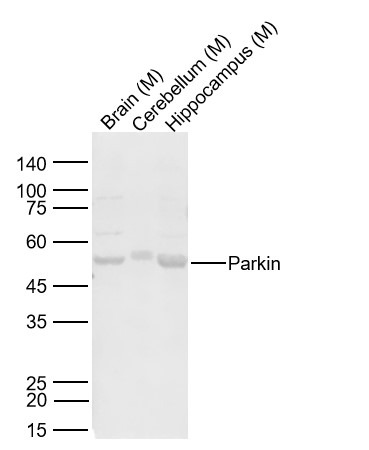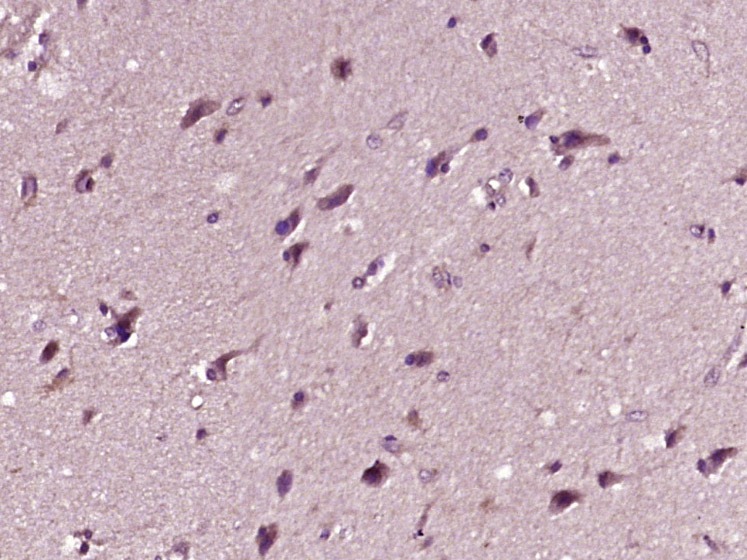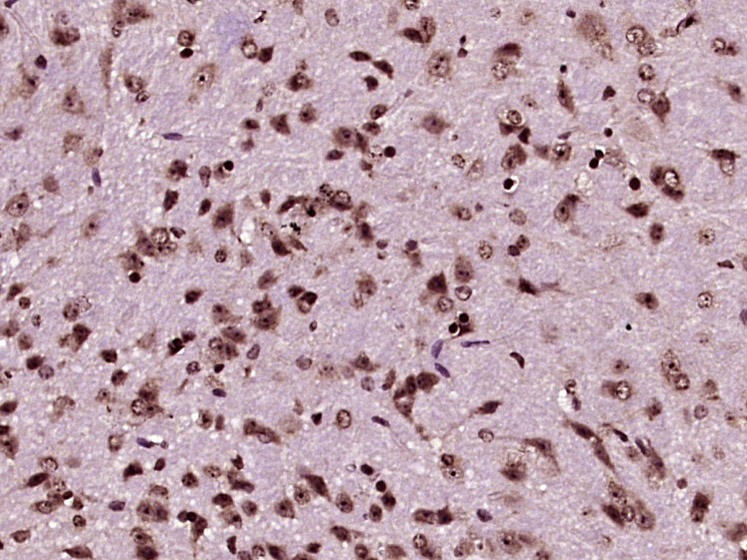购物车
全部删除  您的购物车当前为空
您的购物车当前为空
别名 PRKN, Parkinson juvenile disease protein 2 (Parkinson disease protein 2), Parkin RBR E3 ubiquitin-protein ligase, Parkin, PARK2, E3 ubiquitin-protein ligase parkin
Anti-PRKN Polyclonal Antibody 是一种 Rabbit 抗体,靶向 PRKN。Anti-PRKN Polyclonal Antibody 可用于 IF,IHC-Fr,IHC-P,WB。
Anti-PRKN Polyclonal Antibody 是一种 Rabbit 抗体,靶向 PRKN。Anti-PRKN Polyclonal Antibody 可用于 IF,IHC-Fr,IHC-P,WB。
| 规格 | 价格 | 库存 | 数量 |
|---|---|---|---|
| 50 μL | ¥ 1,165 | 5日内发货 | |
| 100 μL | ¥ 1,970 | 5日内发货 | |
| 200 μL | ¥ 2,790 | 5日内发货 |
| 产品描述 | Anti-PRKN Polyclonal Antibody is a Rabbit antibody targeting PRKN. Anti-PRKN Polyclonal Antibody can be used in IF,IHC-Fr,IHC-P,WB. |
| 别名 | PRKN, Parkinson juvenile disease protein 2 (Parkinson disease protein 2), Parkin RBR E3 ubiquitin-protein ligase, Parkin, PARK2, E3 ubiquitin-protein ligase parkin |
| Ig Type | IgG |
| 反应种属 | Human,Mouse (predicted:Rat,Pig,Cow,Sheep) |
| 验证活性 | 1. Sample: Lane 1: Mouse Brain Lysates Lane 2: Mouse Cerebellum Lysates Lane 3: Mouse Hippocampus Lysates Primary: Anti-Parkin (TMAB-01573) at 1/1000 dilution Secondary: IRDye800CW Goat Anti-Rabbit IgG at 1/20000 dilution Predicted band size: 51 kDa Observed band size: 51 kDa 2. Paraformaldehyde-fixed, paraffin embedded (human brain glioma); Antigen retrieval by boiling in sodium citrate buffer (pH6.0) for 15 min; Block endogenous peroxidase by 3% hydrogen peroxide for 20 min; Blocking buffer (normal goat serum) at 37°C for 30 min; Antibody incubation with (Parkin) Polyclonal Antibody, Unconjugated (TMAB-01573) at 1:400 overnight at 4°C, followed by operating according to SP Kit (Rabbit) instructionsand DAB staining. 3. Paraformaldehyde-fixed, paraffin embedded (Mouse brain); Antigen retrieval by boiling in sodium citrate buffer (pH6.0) for 15 min; Block endogenous peroxidase by 3% hydrogen peroxide for 20 min; Blocking buffer (normal goat serum) at 37°C for 30 min; Antibody incubation with (Parkin) Polyclonal Antibody, Unconjugated (TMAB-01573) at 1:400 overnight at 4°C, followed by operating according to SP Kit (Rabbit) instructions and DAB staining.    |
| 应用 | IFIHC-FrIHC-PWB |
| 推荐剂量 | WB: 1:500-2000; IHC-P: 1:100-500; IHC-Fr: 1:100-500; IF: 1:100-500 |
| 抗体种类 | Polyclonal |
| 宿主来源 | Rabbit |
| 亚细胞定位 | Cytoplasm, cytosol. Nucleus. Endoplasmic reticulum. Mitochondrion. Note=Mainly localizes in the cytosol. Co-localizes with SYT11 in neutrites. Co-localizes with SNCAIP in brainstem Lewy bodies. Relocates to dysfunctional mitochondria that have lost the mitochondrial membrane potential; recruitment to mitochondria is PINK1-dependent. |
| 组织特异性 | Highly expressed in the brain including the substantia nigra. Expressed in heart, testis and skeletal muscle. Expression is down-regulated or absent in tumor biopsies, and absent in the brain of PARK2 patients. Overexpression protects dopamine neurons fro |
| 构建方式 | Polyclonal Antibody |
| 纯化方式 | Protein A purified |
| 性状 | Liquid |
| 缓冲液 | 0.01M TBS (pH7.4) with 1% BSA, 0.02% Proclin300 and 50% Glycerol. |
| 浓度 | 1 mg/mL |
| 研究背景 | Parkinson's Disease, the second most common neurodegenerative disease after Alzheimer's Disease, is characterized by the loss of dopaminergic neurons and the presence of Lewy bodies (comprised of alpha synuclein and parkin inclusions). Autosomal Recessive Juvenile Parkinsonism (AR-JP) is a recently described form of Parkinson's Disease that has been linked to a gene that codes for parkin. Parkin, a 52 kDa protein, has a suggested role in the ubiquitin/proteasome pathway for protein degradation. The amino terminus bears sequence homology to ubiquitin while functionally it acts as a RING type ubiquitin protein ligase (E3) that coordinates the transfer of ubiquitin to substrate proteins, thus targeting them for degradation by the proteasome. |
| 免疫原 | KLH conjugated synthetic peptide: human Parkin |
| 抗原种属 | Human |
| 基因名称 | PRKN |
| 基因ID | |
| 蛋白名称 | E3 ubiquitin-protein ligase parkin |
| Uniprot ID | |
| 研究领域 | Parkin / PARK,Mitophagy fission and fusion,RING Finger E3 Ligase |
| 功能 | Functions within a multiprotein E3 ubiquitin ligase complex, catalyzing the covalent attachment of ubiquitin moieties onto substrate proteins, such as BCL2, SYT11, CCNE1, GPR37, STUB1, a 22 kDa O-linked glycosylated isoform of SNCAIP, SEPT5, ZNF746 and AIMP2. Mediates monoubiquitination as well as 'Lys-48'-linked and 'Lys-63'-linked polyubiquitination of substrates depending on the context. Participates in the removal and/or detoxification of abnormally folded or damaged protein by mediating 'Lys-63'-linked polyubiquitination of misfolded proteins such as PARK7: 'Lys-63'-linked polyubiquitinated misfolded proteins are then recognized by HDAC6, leading to their recruitment to aggresomes, followed by degradation. Mediates 'Lys-63'-linked polyubiquitination of SNCAIP, possibly playing a role in Lewy-body formation. Mediates monoubiquitination of BCL2, thereby acting as a positive regulator of autophagy. Promotes the autophagic degradation of dysfunctional depolarized mitochondria. Mediates 'Lys-48'-linked polyubiquitination of ZNF746, followed by degradation of ZNF746 by the proteasome; possibly playing a role in role in regulation of neuron death. Limits the production of reactive oxygen species (ROS). Loss of this ubiquitin ligase activity appears to be the mechanism underlying pathogenesis of PARK2. May protect neurons against alpha synuclein toxicity, proteasomal dysfunction, GPR37 accumulation, and kainate-induced excitotoxicity. May play a role in controlling neurotransmitter trafficking at the presynaptic terminal and in calcium-dependent exocytosis. Regulates cyclin-E during neuronal apoptosis. May represent a tumor suppressor gene. |
| 分子量 | Theoretical: 51 kDa. |
| 储存方式 | Store at -20°C or -80°C for 12 months. Avoid repeated freeze-thaw cycles. |
| 运输方式 | Shipping with blue ice. |
| 存储 | store at low temperature | store at -20°C |